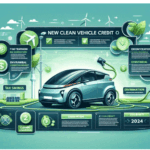Home energy tax credits
If you make energy improvements to your home, tax credits are available for a portion of qualifying expenses. The credit amounts and types of qualifying expenses were expanded by the Inflation Reduction Act of 2022.
We’ll help you compare the credits and decide whether they apply to expenses you’ve already paid or will apply to improvements you’re planning for the future.
Who can claim the credits
You can claim either the Energy Efficient Home Improvement Credit or the Residential Clean Energy Credit for the year when you make qualifying improvements.
Homeowners who improve their primary residence will find the most opportunities to claim a credit for qualifying expenses. Renters may also be able to claim credits, as well as owners of second homes used as residences.
The credits are never available for improvements made to homes that you don’t use as a residence.
Energy Efficient Home Improvement Credit
These expenses may qualify if they meet requirements detailed on energy.gov:
- Exterior doors, windows, skylights and insulation materials
- Central air conditioners, water heaters, furnaces, boilers and heat pumps
- Biomass stoves and boilers
- Home energy audits
The amount of the credit you can take is a percentage of the total improvement expenses in the year of installation:
- 2022: 30%, up to a lifetime maximum of $500
- 2023 through 2032: 30%, up to a maximum of $1,200 (heat pumps, biomass stoves and boilers have a separate annual credit limit of $2,000), no lifetime limit
Get details on the Energy Efficient Home Improvement Credit.
Residential Clean Energy Credit
These expenses may qualify if they meet requirements detailed on energy.gov:
- Solar, wind and geothermal power generation
- Solar water heaters
- Fuel cells
- Battery storage (beginning in 2023)
The amount of the credit you can take is a percentage of the total improvement expenses in the year of installation:
- 2022 to 2032: 30%, no annual maximum or lifetime limit
- 2033: 26%, no annual maximum or lifetime limit
- 2034: 22%, no annual maximum or lifetime limit
Get details on the Residential Clean Energy Credit.
UPDATED JULY 2024
Visit our Energy Savings Hub to learn more about saving money on home energy upgrades, clean vehicles, and more.
|
EQUIPMENT TYPE |
TAX CREDIT AVAILABLE FOR 2023-2032 TAX YEARS |
|
Home Clean Electricity Products |
|
|
Solar (electricity) |
30% of cost |
|
Fuel Cells |
|
|
Wind Turbine |
|
|
Battery Storage |
|
|
Heating, Cooling, and Water Heating |
|
|
Heat pumps |
30% of cost, up to $2,000 per year |
|
Heat pump water heaters |
|
|
Biomass stoves |
|
|
Geothermal heat pumps |
30% of cost |
|
Solar (water heating) |
|
|
Efficient air conditioners* |
30% of cost, up to $600 |
|
Efficient heating equipment* |
|
|
Efficient water heating equipment* |
30% of cost, up to $600 |
|
Other Energy Efficiency Upgrades |
|
|
Electric panel or circuit upgrades for new electric equipment* |
30% of cost, up to $600 |
|
Insulation materials* |
30% of cost |
|
Windows, including skylights* |
30% of cost, up to $600 |
|
Exterior doors* |
30% of cost, up to $500 for doors (up to $250 each) |
|
Home Energy Audits* |
30% of cost, up to $150 |
|
Home Electric Vehicle Charger |
30% of cost, up to $1,000 ** |
|
* Subject to cap of $1200/year |
|
Q: Who is eligible for tax credits?
A: Homeowners, including renters for certain expenditures, who purchase energy and other efficient appliances and products.
Q: What do consumers do to get the credit(s)?
A: Fill out IRS Form 5695, following IRS instructions, and include it when filing your tax return. Include any relevant product and services receipts.
Q: Are there limits to what consumers can claim?
A: Consumers can claim the same or varying credits year after year with new products purchased, but some credits have an annual limit. See the table above.
Q: How do I know if my Home Energy Audit is eligible for a credit?
A: Consumers can visit this IRS page on the Energy Efficient Home Improvement Credit.
Q: What products are eligible for tax credits?
- Home clean electricity products
- Solar panels for electricity from a provider in your area.
- Home back-up power battery storage with capacity of 3 kWh or greater.
- Heating, cooling, and water heating
- Electric or natural gas heat pumps; electric or natural gas heat pump water heaters; central air conditioners; natural gas or propane or oil water heaters; natural gas or propane or oil furnaces or hot water boilers that meet or exceed the specific efficiency tiers established by the Consortium for Energy Efficiency. Eligible products here: CEE Directory.
- Solar water heating products that are certified for performance by the Solar Rating Certification Corporation or comparable entity endorsed by the state government in which product is installed. See: https://solar-rating.org.
- Other energy efficiency upgrades
- Oil furnaces or hot water boilers if they meet or exceed 2021 Energy Star efficiency criteria and are rated by the manufacturer for use with fuel blends at least 20% of the volume of which consists of an eligible fuel. See: https://www.energystar.gov/products.
- Panelboards, sub-panelboards, branch circuits, or feeders that are installed according to National Electrical Code and have load capacity of 200 amps or more.
- Insulation materials and systems that meet International Energy Conservation Code standards. See: Building Energy Codes Program.
- Exterior windows that meet Energy Star’s Most Efficient requirements. See: https://www.energystar.gov/products/most_efficient.
Q: What if I have questions about products, standards, codes or other eligibility referenced above?
A: Ask a trusted contractor, plumber, or electrician.
Q: Where do I get even more detailed information?
A: More information on the energy efficient home improvement credit and residential clean energy property credit is available for tax professionals, building contractors, and others. See:
- IRS.gov/HomeEnergy
- Department of Treasury Taxpayer Resource Hub
- IRS FAQ about Energy Efficient Home Improvements and Residential Clean Energy Property Credits
Q: What’s the difference between a tax credit and a rebate?
A: If you’re a little confused on the difference between the two, or don’t know how they work—not to worry. Just review our video and go to /save and see which home energy upgrades are right for you.



